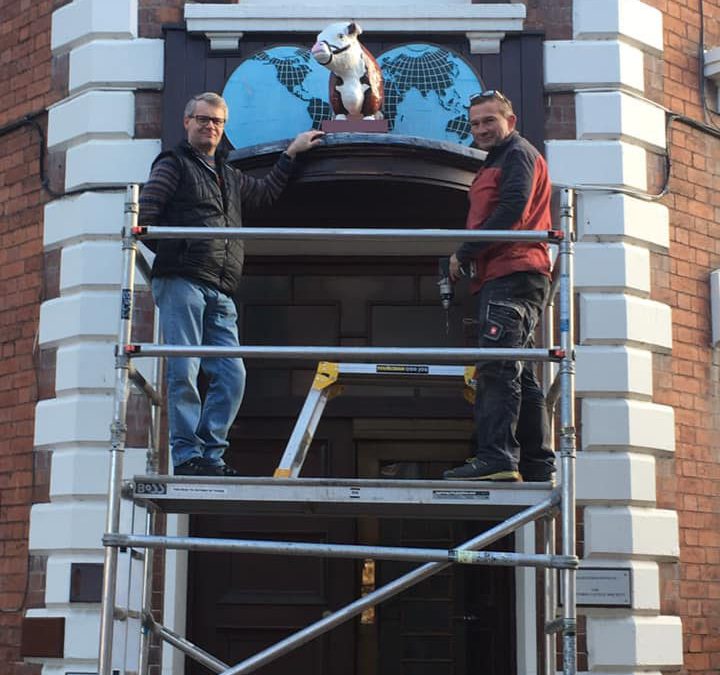
A complete restoration of the ‘Iconic Bull’ on display outside Hereford House.
One of our long-standing members, Antony Halls, a sculptor and artist has recently carried out a remarkable restoration of the Hereford Bull which sat above the entrance to the Hereford Cattle Society at Hereford House. Here he describes the project…..
I have been associated with the Hereford Cattle Society for several years, having sculpted Hereford Cattle models for commercial companies. The models had to be shown to and approved by the Society before going into production. I also create my own Hereford Cattle products which I sell to the public.
At the end of June, this year, it became apparent that the ‘Iconic Bull’ was missing from above the entrance to Hereford House, where it had been on display for the past 30 years. I contacted David Deakin at the Society after reading that the bull had been damaged and removed from its over-door plinth. I asked him if I could look at the bull with a view to repairing it free of charge for the Society. David welcomed a visit and when I saw the bull, my heart sank.  It was in very bad shape having been subjected to 30 years of constant weather abuse and finally, being struck by a lorry. The evidence was apparent. The front curve of the plinth above the main doors of Hereford House was scraped and the leadwork had been pushed up. The bull had to have been struck as well. I loaded it into the back of our estate car. It filled the space and to top it all, it was very heavy. It weighed 79 lbs. Yes, I put it on the scales when I got it home!
It was in very bad shape having been subjected to 30 years of constant weather abuse and finally, being struck by a lorry. The evidence was apparent. The front curve of the plinth above the main doors of Hereford House was scraped and the leadwork had been pushed up. The bull had to have been struck as well. I loaded it into the back of our estate car. It filled the space and to top it all, it was very heavy. It weighed 79 lbs. Yes, I put it on the scales when I got it home!
Now the very strange thing about all of this, is that I sculpt with waxes and clay. The bull in this instance had been carved with mahogany. I don’t really work with wood as a rule but was certainly up for a challenge. My initial thought when I first saw it was perhaps it would be a simple fix. That completely went out the window when I got it on the workbench. The whole bull was misaligned.
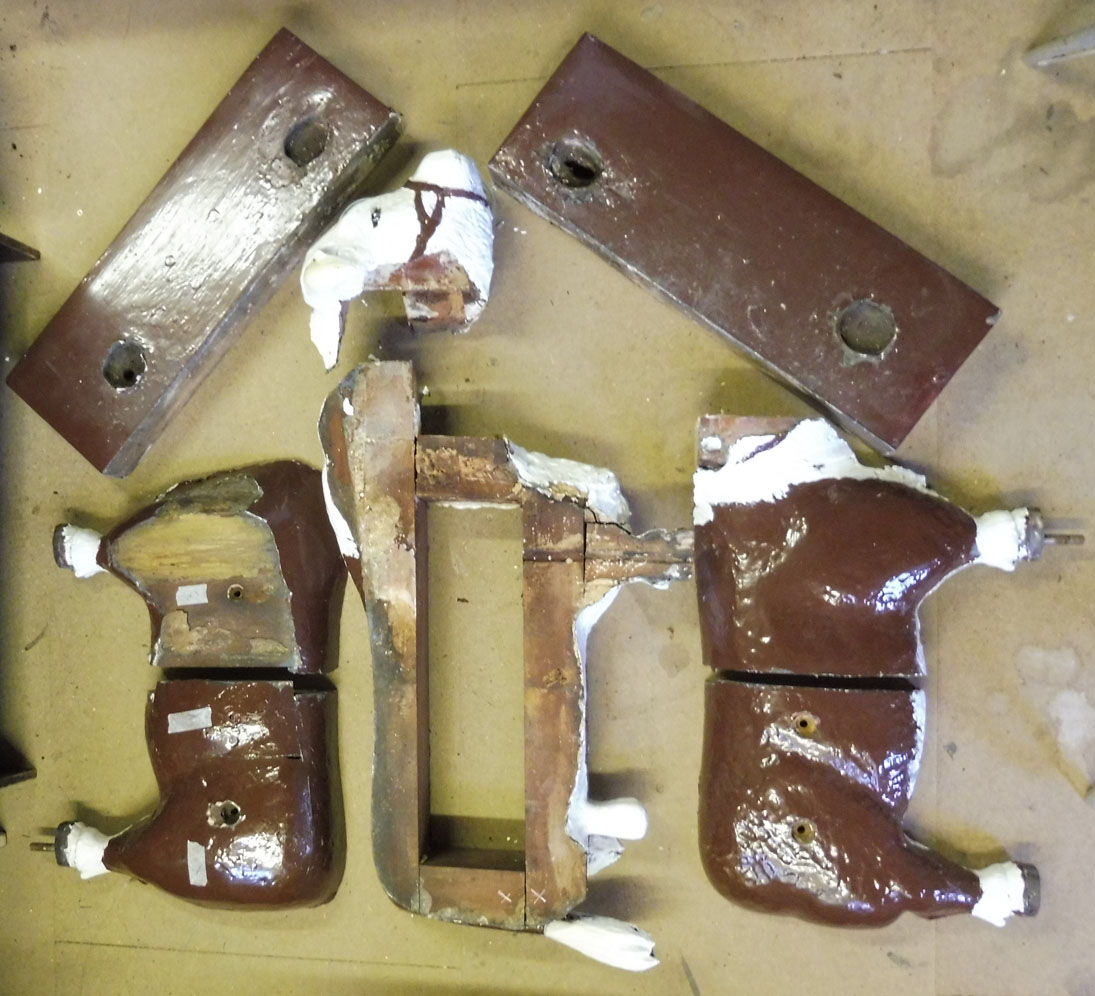 The base which was made in two parts had parted company. The only thing holding the bull together was three threaded bolts running from one side to the other along the body, and a threaded bolt in one front hoof on one side and one bolt on the rear hoof on the other side. One of the body pieces that had been found on the pavement outside of Hereford House, had revealed a steel nut hinting at a threaded bolt. I contacted David to explain the extent of the damage and during our discussion, we talked about the possibility of starting over and creating a new bull. Whilst being capable of doing that, possibly making it with fibreglass, I felt that the original should be reinstated. This would mean taking the bull to pieces and rebuilding it. David was more than happy with this and I set about renovating the iconic piece of artwork, returning it to its original former glory. The Society agreed to pay for any materials needed to restore it with my labour given free. I told David it would take a while because I was only able to give it my attention when I could find free time to work on it, mainly in the evenings. Over the next five months, it took me just over 72 hours from start to finish. I was very fortunate during the repair journey. My next-door neighbour, Martin Dixon is a professional joiner/carpenter. He gave me advice all the way through and made the new base for me. The Mahogany two-part base was rotted through around the hooves because of water getting into the joints. The new base is a piece of air-dried Douglas Fir and more importantly one piece. The Douglas Fir, along with taking 4 inches out of the width, helped reduce the overall weight by about 9lbs. It certainly helped me with having to lift it all the time during the repair towards the end. Every single one of the glued joints had given way. All told, there were 29 pieces of Mahogany making up the entire bull. I had to strip all the layers of paint off the wood using a paint stripper gun, as well as cleaning up every joint, removing the old glue. It became apparent that the weakness in the construction of the Bull was because of the pieces being glued without any strengthening. Martin advised me to strengthen the joints with biscuits. Now I don’t mean using ‘Custard Creams’, my favourite biscuits.
The base which was made in two parts had parted company. The only thing holding the bull together was three threaded bolts running from one side to the other along the body, and a threaded bolt in one front hoof on one side and one bolt on the rear hoof on the other side. One of the body pieces that had been found on the pavement outside of Hereford House, had revealed a steel nut hinting at a threaded bolt. I contacted David to explain the extent of the damage and during our discussion, we talked about the possibility of starting over and creating a new bull. Whilst being capable of doing that, possibly making it with fibreglass, I felt that the original should be reinstated. This would mean taking the bull to pieces and rebuilding it. David was more than happy with this and I set about renovating the iconic piece of artwork, returning it to its original former glory. The Society agreed to pay for any materials needed to restore it with my labour given free. I told David it would take a while because I was only able to give it my attention when I could find free time to work on it, mainly in the evenings. Over the next five months, it took me just over 72 hours from start to finish. I was very fortunate during the repair journey. My next-door neighbour, Martin Dixon is a professional joiner/carpenter. He gave me advice all the way through and made the new base for me. The Mahogany two-part base was rotted through around the hooves because of water getting into the joints. The new base is a piece of air-dried Douglas Fir and more importantly one piece. The Douglas Fir, along with taking 4 inches out of the width, helped reduce the overall weight by about 9lbs. It certainly helped me with having to lift it all the time during the repair towards the end. Every single one of the glued joints had given way. All told, there were 29 pieces of Mahogany making up the entire bull. I had to strip all the layers of paint off the wood using a paint stripper gun, as well as cleaning up every joint, removing the old glue. It became apparent that the weakness in the construction of the Bull was because of the pieces being glued without any strengthening. Martin advised me to strengthen the joints with biscuits. Now I don’t mean using ‘Custard Creams’, my favourite biscuits. 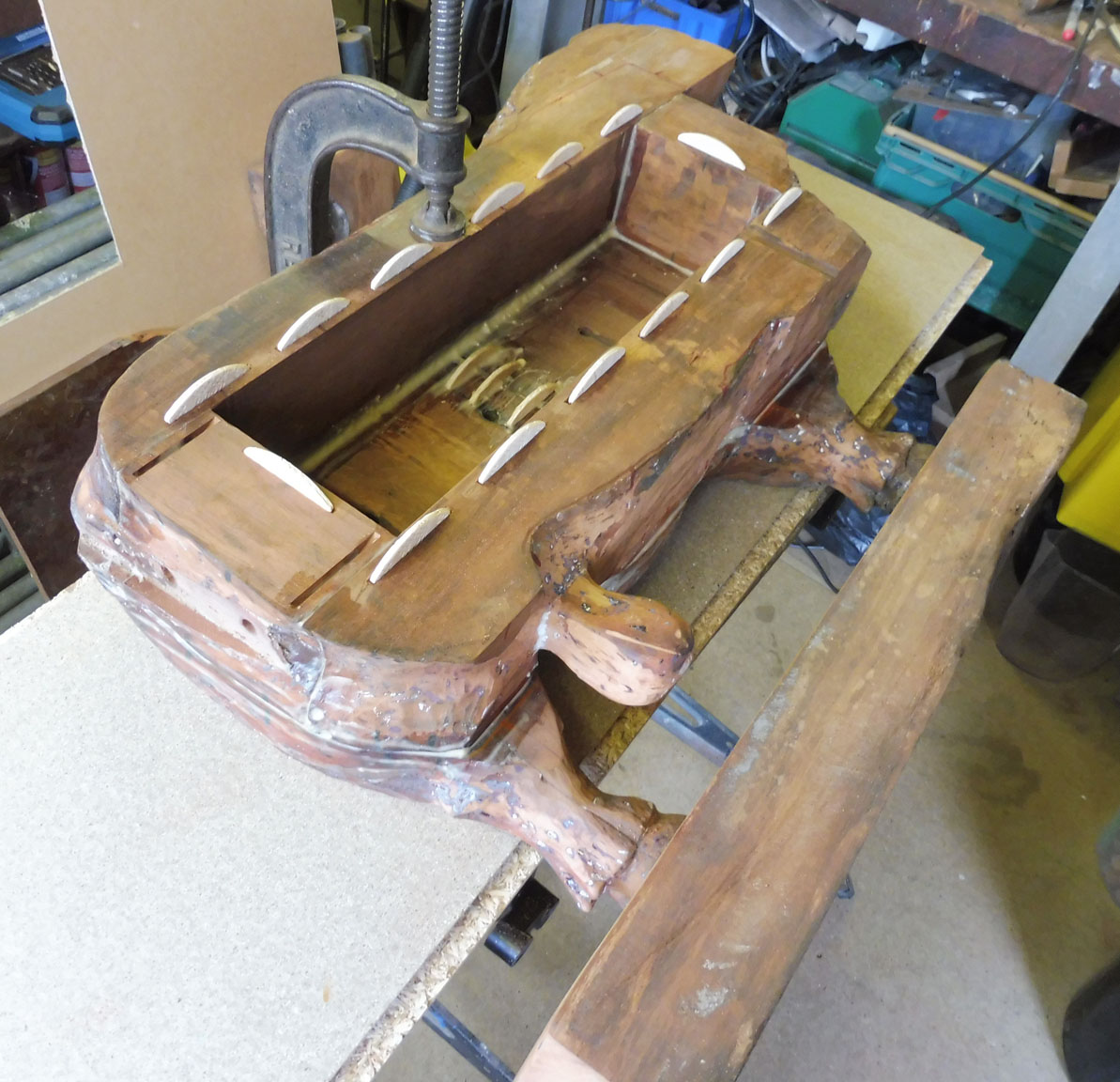 A biscuit is a rugby ball shaped piece of wood. I used a special piece of equipment called a Biscuit Jointer. This cuts a slot into the wood, by where the biscuit is glued into the slot, with a matching slot on the opposite side. This means that there is no longer any lateral movement once the glue has cured. The glue I used is called Cascamite, which is a resin-based glue that is waterproof when fully cured. In all, I used roughly 100 biscuits throughout the restoration. I kept a complete photographic record of the journey, taking in excess of 600 photos. I had to do a bit of reconstruction along the way. The original face was a little distorted and I improved the symmetry, also giving the brisket a better shape. For me an interesting aspect of the restoration was having to do a bit of wood carving.
A biscuit is a rugby ball shaped piece of wood. I used a special piece of equipment called a Biscuit Jointer. This cuts a slot into the wood, by where the biscuit is glued into the slot, with a matching slot on the opposite side. This means that there is no longer any lateral movement once the glue has cured. The glue I used is called Cascamite, which is a resin-based glue that is waterproof when fully cured. In all, I used roughly 100 biscuits throughout the restoration. I kept a complete photographic record of the journey, taking in excess of 600 photos. I had to do a bit of reconstruction along the way. The original face was a little distorted and I improved the symmetry, also giving the brisket a better shape. For me an interesting aspect of the restoration was having to do a bit of wood carving. 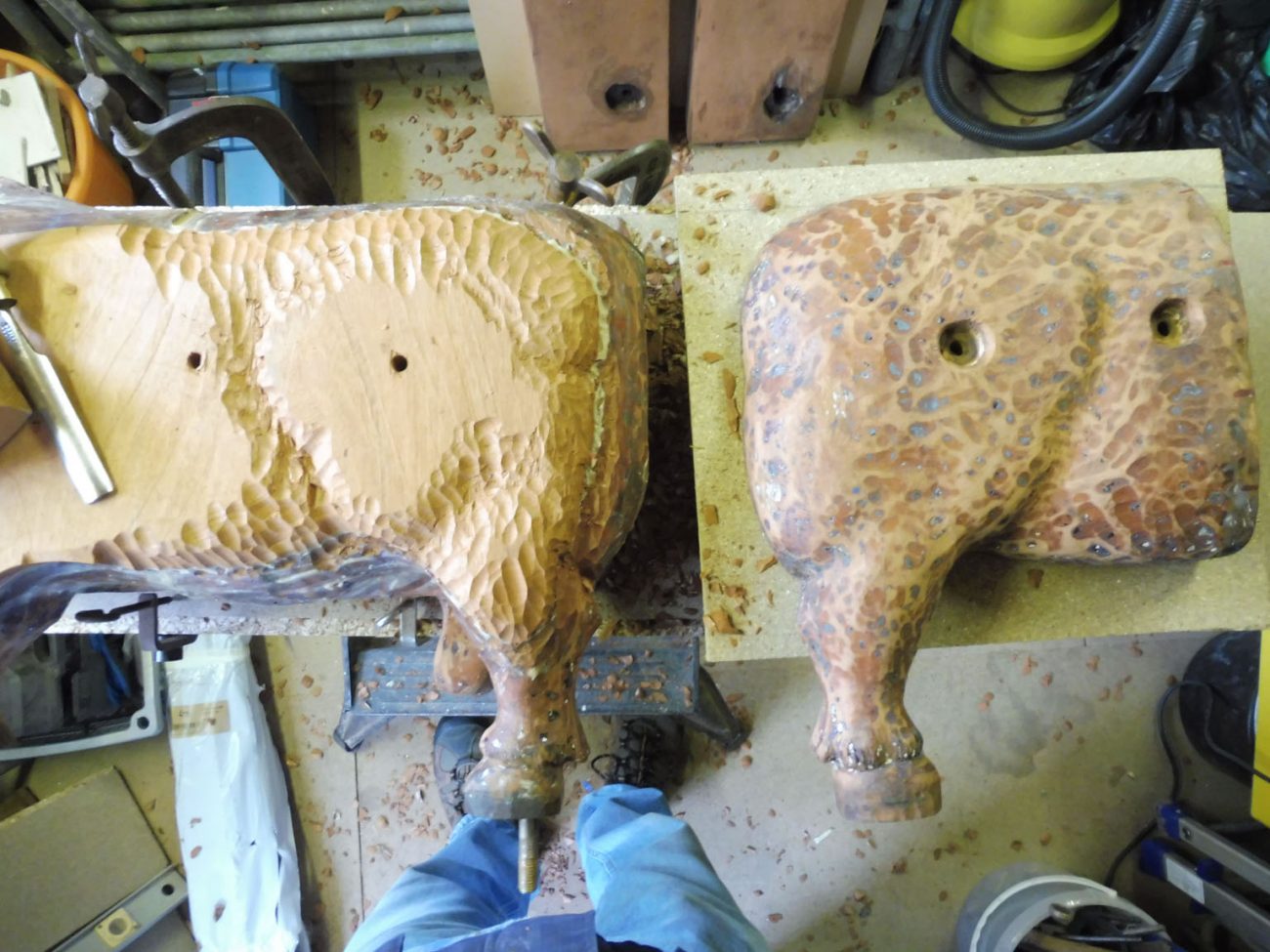 It is something I plan to take up one day when I retire, as a hobby. I doubt it will ever happen though, but I can dream. However, the left- hand side of the outer body had to be replaced. Whoever created the bull had used five pieces of mahogany for this side. Two pieces were missing. I replaced them all with one piece of mahogany, which I had to carve. I very much enjoyed this part of the project. I think I did a pretty good job. In order to water tight every joint, I had to use a specialist material, which is green in colour, that would move with the joints as they are subjected to the ever changing weather patterns that will be thrown at it over the coming years. I am hoping that the renovated bull will stay in one piece for many decades, if not more. The final part of the restoration was routing (using a router which is a power tool used to hollow out wood) the hoof shapes in the base and gluing the bull, after adding two more threaded bolts to the other hooves, onto the base. Now having all four hooves bolted and glued in using the specialist compound, means there is double the strength and no chance of water getting past the hooves.
It is something I plan to take up one day when I retire, as a hobby. I doubt it will ever happen though, but I can dream. However, the left- hand side of the outer body had to be replaced. Whoever created the bull had used five pieces of mahogany for this side. Two pieces were missing. I replaced them all with one piece of mahogany, which I had to carve. I very much enjoyed this part of the project. I think I did a pretty good job. In order to water tight every joint, I had to use a specialist material, which is green in colour, that would move with the joints as they are subjected to the ever changing weather patterns that will be thrown at it over the coming years. I am hoping that the renovated bull will stay in one piece for many decades, if not more. The final part of the restoration was routing (using a router which is a power tool used to hollow out wood) the hoof shapes in the base and gluing the bull, after adding two more threaded bolts to the other hooves, onto the base. Now having all four hooves bolted and glued in using the specialist compound, means there is double the strength and no chance of water getting past the hooves.  What with three brand new threaded bolts running through the body as well, if another lorry happens to hit the bull, and I sincerely hope one doesn’t, the bull can’t possibly fall to pieces, because of the way I have reconstructed it. All I had to do then was paint the bull.
What with three brand new threaded bolts running through the body as well, if another lorry happens to hit the bull, and I sincerely hope one doesn’t, the bull can’t possibly fall to pieces, because of the way I have reconstructed it. All I had to do then was paint the bull. 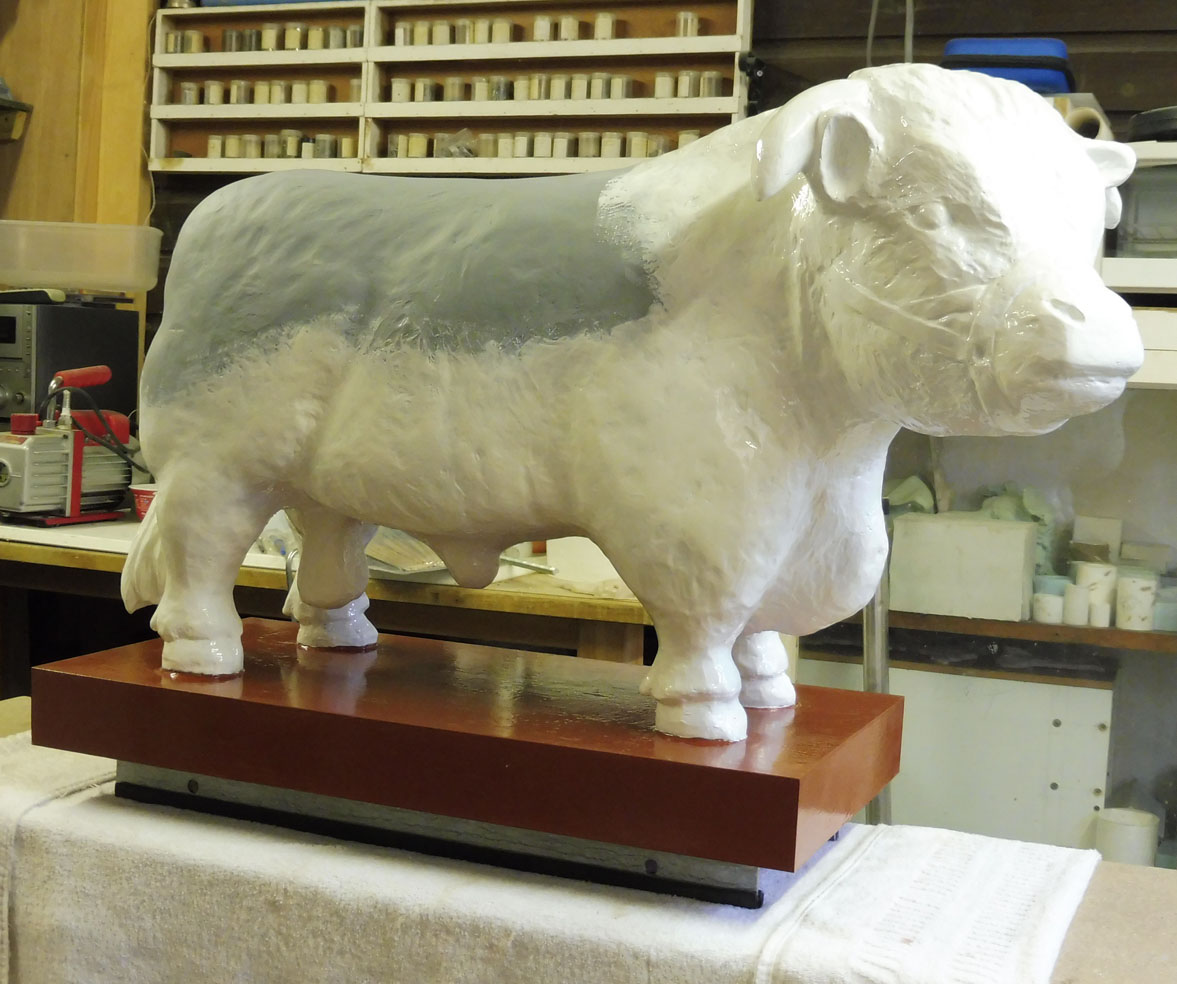 Over the years, someone had repainted the original coat and the character of the coat colour and pattern had been lost. It needed to look right, and I used a special marine paint. There are four coats of each colour. An aluminium oxide undercoat, followed by white, then a red brick brown. There followed detailing and a final coat of Hammerite Aluminium paint on the steel rails attached to the bottom of the base which fixes the bull to the roof plinth.
Over the years, someone had repainted the original coat and the character of the coat colour and pattern had been lost. It needed to look right, and I used a special marine paint. There are four coats of each colour. An aluminium oxide undercoat, followed by white, then a red brick brown. There followed detailing and a final coat of Hammerite Aluminium paint on the steel rails attached to the bottom of the base which fixes the bull to the roof plinth.
 When finished, I loaded the bull into the back of the car and took it to the Society for approval. All that was left to do, was to put it back where it rightly belonged.
When finished, I loaded the bull into the back of the car and took it to the Society for approval. All that was left to do, was to put it back where it rightly belonged.
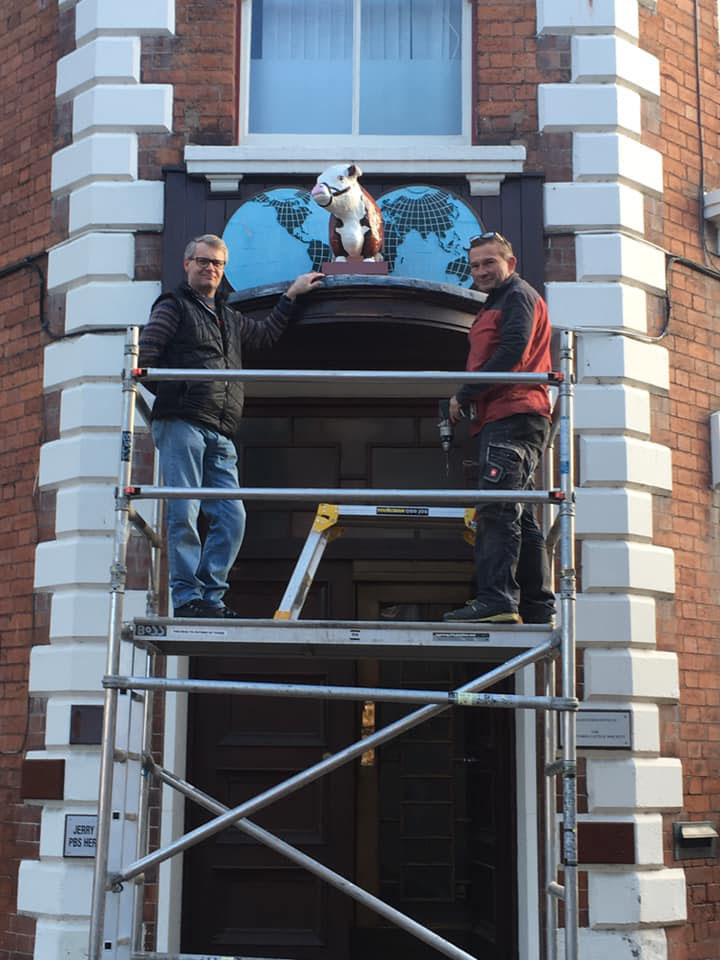 Martin Dixon, my mentor and neighbour, very kindly offered his time to help get it onto the roof. We took his mini scaffolding tower to Hereford House and met David Deakin. Martin repaired the lead flashing that the lorry had damaged and fitted the bull back onto the base. I am completely indebted to Martin throughout the whole journey. I could not have done it without his guidance and help. David, meanwhile, took photographs of us working up on the scaffolding tower.
Martin Dixon, my mentor and neighbour, very kindly offered his time to help get it onto the roof. We took his mini scaffolding tower to Hereford House and met David Deakin. Martin repaired the lead flashing that the lorry had damaged and fitted the bull back onto the base. I am completely indebted to Martin throughout the whole journey. I could not have done it without his guidance and help. David, meanwhile, took photographs of us working up on the scaffolding tower.
We can never forget the date the bull returned home: the morning of 10th November 2019. We finished 20 minutes before the Armistice Service began in St Peter’s Square.

